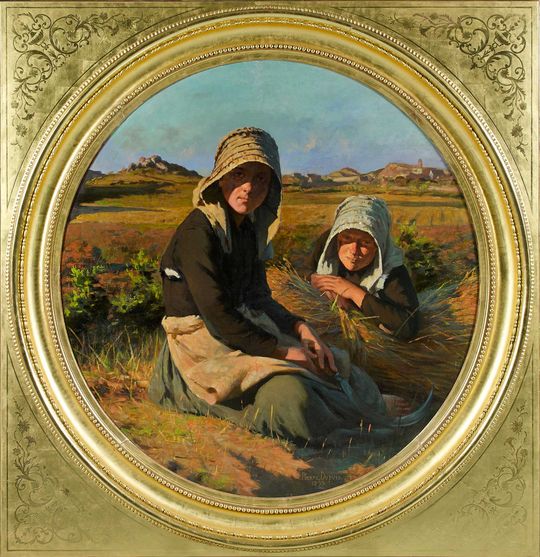LES MOISSONNEUSES (ÎLE DE BRÉHAT, BRETAGNE)
1893

Oil on canvas
2014-3-1
Acquired at Artcurial with the support of the FRAM (National French Funds for Museums)
Diamètre : 150 cm
The island of Bréhat sheltered an important colony of painters at the end of the 19th century.
This large painting dates from 1893 and is presented to the Paris public in 1894. Its subject is part of the enthusiasm that has known Brittany for two decades to many artists. Dupuis, on his side, became a Bréhat familiar from the mid-1880s and will remain faithful to the island until his death. Adopting a photographic framing, the choice of a telescope format accentuating the zoom effect, Dupuis describes, with a sincerity devoid of cleverness, two young Bréhatines. Fascinating with presence and authority, they dominate a vast landscape of moors and fields closed by a hamlet and strong rocky outcrops. Dupuis.The light, though toned down by the late hour, is treated crudely and becomes almost garish in the range of oranges that irides the ripe wheat or the face of our two harvesters.
LES MOISSONNEUSES (ÎLE DE BRÉHAT, BRETAGNE)
1893

Oil on canvas
2014-3-1
Acquired at Artcurial with the support of the FRAM (National French Funds for Museums)
Diamètre : 150 cm
The island of Bréhat sheltered an important colony of painters at the end of the 19th century.
This large painting dates from 1893 and is presented to the Paris public in 1894. Its subject is part of the enthusiasm that has known Brittany for two decades to many artists. Dupuis, on his side, became a Bréhat familiar from the mid-1880s and will remain faithful to the island until his death. Adopting a photographic framing, the choice of a telescope format accentuating the zoom effect, Dupuis describes, with a sincerity devoid of cleverness, two young Bréhatines. Fascinating with presence and authority, they dominate a vast landscape of moors and fields closed by a hamlet and strong rocky outcrops. Dupuis.The light, though toned down by the late hour, is treated crudely and becomes almost garish in the range of oranges that irides the ripe wheat or the face of our two harvesters.
